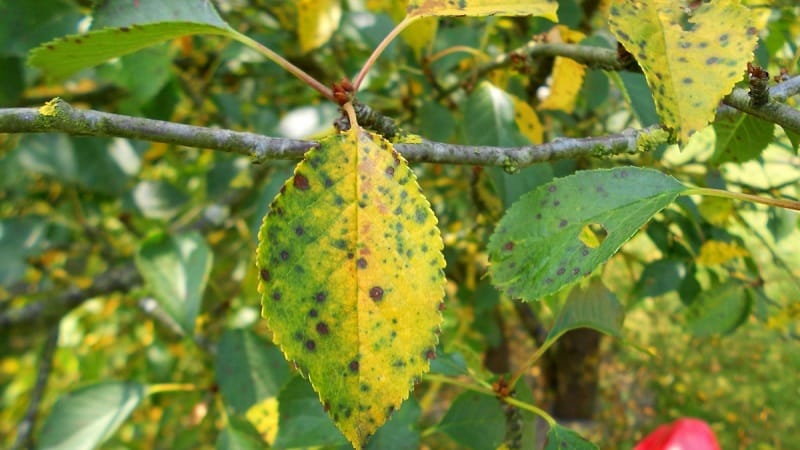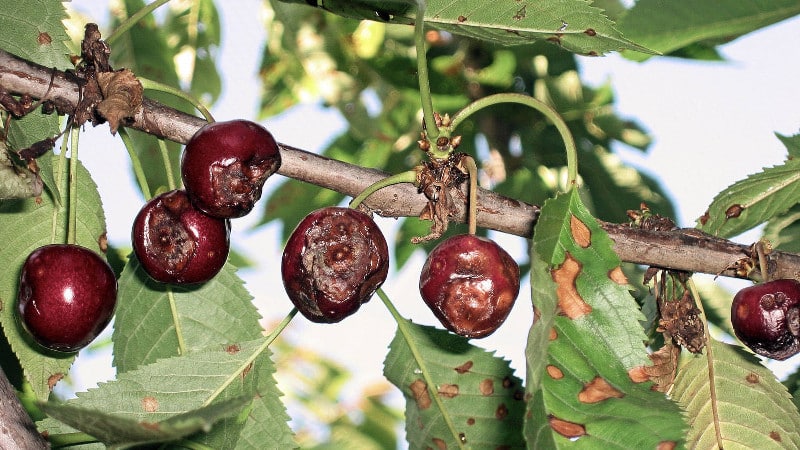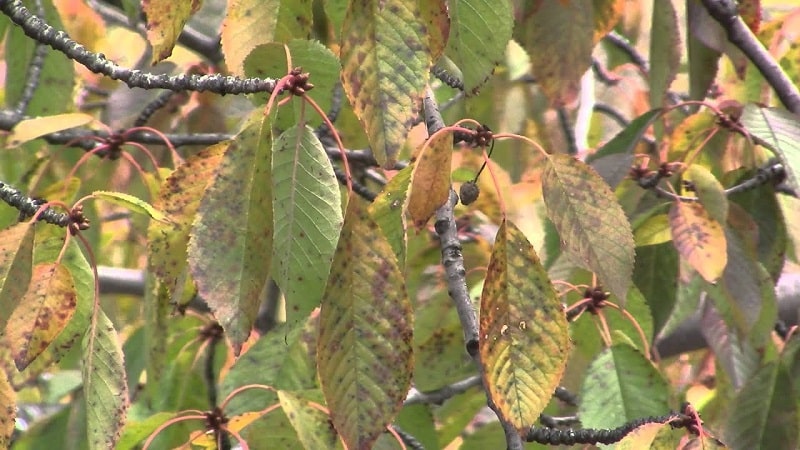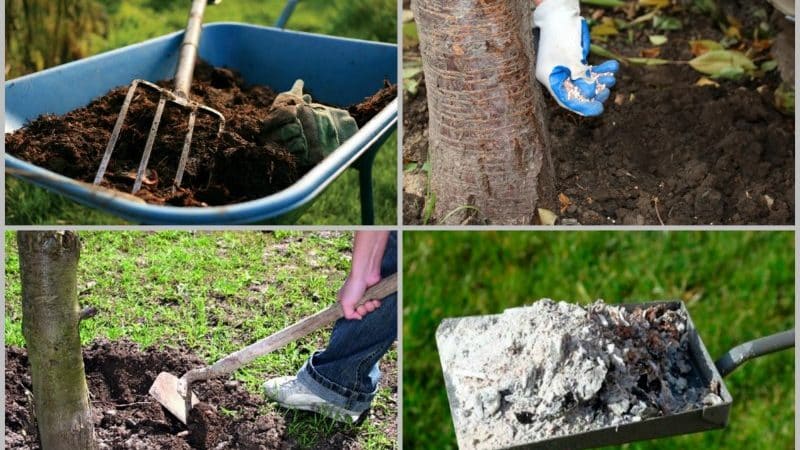Why do cherry leaves turn yellow in July and how to treat the tree correctly
The foliage on a healthy cherry tree turns yellow and falls off in the autumn. But if it changes color in the summer, this indicates problems that can be caused by various reasons. Let's figure out what to do if the leaves on a cherry tree turn yellow in July, how to treat the plant and what preventive measures to take.
Reasons for yellowing of cherry leaves in July
There are several reasons why leaves turn yellow:
- deficiency of nutrients in the soil;
- various diseases;
- pests;
- errors during planting and care.
If measures are not taken in time, you can lose the entire crop or treewhich will begin to dry out and die.

Nutritional deficiencies
Cherries needs regular feeding throughout the growing season. If they are forgotten or dosages are not followed, nutritional deficiencies occur.
If the soil for cherries is not entirely suitable, contains excess chalk or lime (alkaline), then the plant does not absorb nutrients well. As a result, the tree weakens, develops poorly, the foliage turns yellow, and the shoots dry out.
How to determine which minerals a plant lacks:
- If there is not enough nitrogen in the soil, the leaves of the cherry are small, pale green or yellowish.
- With phosphorus deficiency, the shoots of the plant are short and dry, the leaves are narrow, and their color changes.
- If there is a lack of potassium in the soil, the foliage becomes bluish, and yellow-brown dots appear on some specimens.
- A lack of calcium is indicated by the death of young greenery on trees.
- If there is not enough boron, chlorosis occurs, in which the veins on the leaf blades turn yellow and they curl.
- When the leaf becomes brittle and brittle and changes color, it means there is a zinc deficiency.
Reference. Excess fertilizer is harmful to the plant. If leaves begin to fall off the cherry tree in July, this may indicate that the tree has been overfed with nitrogen-containing fertilizers.
Diseases
There are no varieties that are completely protected from various diseasesTherefore, it is recommended to regularly inspect trees. Timely treatment will save the harvest and the plant itself.
Coccomycosis
Coccomycosis is a fungal disease. It's common in central Russia. It affects both young and mature trees. First, small spots of red and brown colors appear on the leaves of the cherry tree. Then they merge into one big spot.

This leads to a 2-fold decrease in the chlorophyll content in the plant, as a result of which the tree loses its ability to retain moisture. The foliage turns yellow and falls off in mid-summer. The plant's immunity decreases, and biological processes are disrupted.
Moniliosis
Moniliosis, or fruit rot, is a fungal disease. Common in regions where it is damp and cool in spring. The fungus attacks cherries during the flowering period.

The main signs of the disease include:
- limp leaves that turn yellow and dry out;
- fading flowers;
- rotting fruits;
- the ends of the shoots look like they are burnt;
- gray growths on the bark.
Verticillium
Verticillium is a dangerous fungal disease that causes plants to dry out.. Usually affects young seedlings.First, the leaves begin to curl along the vein. The blossoming buds wither. The set berries are not able to ripen. Then the leaves turn yellow, the tree sheds its leaves and becomes bare.

Scab
Cherry scab is a fungal disease that harms the harvest.. On the affected tree, the leaves become covered with yellow spots. Then they darken and crack. The spread of the disease is facilitated by high humidity, dense plantings and lack of sunlight.

Chlorosis
Chlorosis is a non-infectious disease. The main signs include yellowing leaves that fall off in the summer. Most often, the disease affects trees growing on alkaline soil, on soils with high groundwater levels when the rootstock and scion of the seedling do not match.

Chlorosis may occur after the plant freezes during a snowless winter. Sweet cherries are susceptible to disease due to a lack of moisture during the heat and when there is an excess of it during heavy rains.
Pests
Pests are another cause of yellowing and falling leaves. To preserve the crop and plant, insects must be detected and destroyed in a timely manner. Most common:
- Chafer. It lays larvae in the roots of the tree. They look like small, fat caterpillars with small legs. The length of insects is from 1.5 to 4 cm.
- Ants. Place the anthill in the roots. They can be found by burrowing at the base of the plant.
- Cherry aphid. This insect sucks the juice from cherry leaves. Aphids are looked for on the tips of branches and young shoots. The size of the pest is no more than 2 mm, so it is difficult to detect.
- Slimy sawfly. It feeds on plant sap.The insect size is from 4 to 6 mm, the color is black or brown.
- Bark beetle It gnaws through the bark of the tree and provokes infection of the cherry tree with fungus.
Agrotechnical errors
Cherry leaves turn yellow, may dry out and fall off in mid-summer due to non-compliance planting technologies and cultivation. This leads not only to loss of yield, but also to the death of the crop.
Most common agricultural mistakes made by inexperienced summer residents:
- Plants are planted in acidic soils (cherries like neutral ones).
- They do not maintain a distance between plantings of up to 2 m.
- Plant cherries in shaded areas.
- Water irregularly or use cold water.
- They do not fertilize the soil or do not comply with fertilizing standards, creating an excess or deficiency of essential microelements.
- Pruning is rarely done, which leads to a thickened crown.
- They use dirty garden tools.
- Do not loosen or mulch the soil under the cherry tree with sawdust or hay.
- Leaves and weeds under the tree are not removed.
What to do, how to save a tree
If the reason for the yellowing of leaves on a cherry tree is When the soil dries out, the tree begins to be watered regularly. Nutrient deficiencies are compensated by feeding the trees with phosphorus, ash or potassium.
When yellowing and falling occurs due to fungal diseases, the following measures are taken:
- after harvesting, the tree is sprayed with 1% Bordeaux mixture (100 g of copper sulfate, 150 g of quicklime per 10 liters of water);
- affected branches are cut off and burned;
- the sections are treated with a special composition, which is made from lime mortar with the addition of iron (3%) or copper sulfate (1%).
Reference. In case of coccomycosis, it is recommended to treat the tree with “Skorom”. To do this, dilute 1 ampoule per 10 liters of water.
Chemicals are also used to treat diseases and pests., for example, “Horus”, “Kaptan”, “Strobi”, “Gamair”. They are used for treatment and prevention. The products are used in accordance with the instructions on the packaging. If entire shoots are affected due to disease or pests, they are removed and burned. After which the plant is treated with mustard solution (100 g of powder per 10 liters of water). Spraying is carried out in the morning. This remedy strengthens the cherry’s immunity and helps it recover.

If the main problem of yellowing is insect pests, then First they try to remove them by hand, after which the wood is treated. Special tape traps are used, insects are washed off with water from a hose, then the soil is watered with boiling water.
Ant holes are filled with a decoction of wormwood or wild mint, or the tree trunk is smeared with tar. The Anteater remedy is also used. May beetle larvae are dug out from the ground and destroyed. Lupine, which is planted next to cherries, helps to get rid of them. Its roots are poisonous to insects.
To cure a plant from chlorosis, use an integrated approach, which improves the condition of the root system:
- water the cherries with soft water from natural reservoirs or rain;
- do not use fresh manure for fertilizing;
- humus with bird droppings is used as nitrogen fertilizers, which is diluted with water 10-12 times;
- for quick help, the tree is sprayed with a solution of iron sulfate (50-70 g per 10 liters of water), the procedure is repeated 3 times after 2 weeks;
- in the autumn, add 150 g of iron sulfate and 10 kg of humus or compost to a depth of 60 cm;
- To improve the oxygen regime in the root system zone, use a solution of potassium permanganate (30-40 g per 10 liters of water), consumption per tree - 10 liters.
To prevent chlorosis before the leaves open, It is recommended to treat the crown with a solution of iron sulfate (300 g per 10 liters of water).
What to do if the leaves fall
When the leaves from the cherry tree begin to fall, experienced gardeners recommend pruning. To do this, remove dry, diseased and bare branches. Such measures prevent the death of the entire tree. After that, fallen leaves and weeds are collected under the cherry tree. Branches and debris are burned.
To protect the plant from leaf fall next year, it is recommended to apply ammophoska before winter. The product is used to fill the grooves under the plant at the rate of 30 g per 1 square meter. m. The base of the cherry tree is sprinkled with dry ash, which strengthens the plant’s immunity.
After pruning, the soil under the tree is loosened and watered with warm water.. Then the weakened plant is fed with complex fertilizers containing iron, nitrogen, potassium, phosphorus, zinc, calcium, copper, boron. For this purpose, products for fruit and berry trees are used: “Gumi-Omi”, “Kemira”, “Magic Leika”.
Interesting things on the site:
Preventive measures
To prevent leaves from yellowing, recommend carrying out preventive measures:
- Purchase varieties that are suitable for the respective region.
- Plant trees in favorable places, away from apple and pear trees.
- Regularly inspect cherries for signs of diseases and pests.
- Carry out timely pruning of the plant in dry weather, using clean tools. Treat wounds with garden varnish.
- Apply water at the root, bypassing leaves, fruits and shoots.
- Feed the plant in a timely manner.
- In the fall, dig up the soil under the tree. Remove weeds and debris.
- Produce lime whitewash in the autumn. To remove fungal spores, copper sulfate is added to the lime.
- Cover cherries for the winter.
Advice from experienced gardeners
To get a large harvest of cherries, experienced gardeners recommend treat the plant with folk remedies. To prepare the solution, use dandelion leaves and stems, chamomile and nettle. They are poured with boiling water in a 1:1 ratio. Leave for 2 days, then spray the plant.
Treatment with fungicides and insecticides is recommended before fruiting begins.so that the harvest is environmentally friendly. During the fruiting period, biological preparations are recommended to be used in case of emergency.
To repel pests, it is recommended to plant crops with a pungent odor (garlic, marigolds, smoking tobacco).
Conclusion
If the leaves of a cherry tree begin to turn yellow in July, it is recommended to immediately find out what caused the problem and fix it. Often the cause is insufficient watering or excess moisture. Leaves also change color due to nutrient deficiencies, insect pests, and fungal diseases.
If you eliminate the cause in a timely manner, you will save the future harvest and the tree itself. Don’t forget about preventive measures that will help prevent the problem.